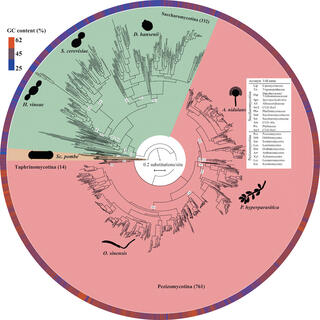Genome-scale phylogeny and contrasting modes of genome evolution in the fungal phylum Ascomycota
X. Shen et al. “Genome-scale phylogeny and contrasting modes of genome evolution in the fungal phylum Ascomycota” Science Advances 6, 45 (2020) [DOI: 10.1126/sciadv.abd0079]
Ascomycota, the largest and most well-studied phylum of fungi, contains three subphyla: Saccharomycotina (budding yeasts), Pezizomycotina (filamentous fungi), and Taphrinomycotina (fission yeasts). Despite its importance, we lack a comprehensive genome-scale phylogeny or understanding of the similarities and differences in the mode of genome evolution within this phylum. By examining 1107 genomes from Saccharomycotina (332), Pezizomycotina (761), and Taphrinomycotina (14) species, we inferred a robust genome-wide phylogeny that resolves several contentious relationships and estimated that the Ascomycota last common ancestor likely originated in the Ediacaran period. Comparisons of genomic properties revealed that Saccharomycotina and Pezizomycotina differ greatly in their genome properties and enabled inference of the direction of evolutionary change. The Saccharomycotina typically have smaller genomes, lower guanine-cytosine contents, lower numbers of genes, and higher rates of molecular sequence evolution compared with Pezizomycotina. These results provide a robust evolutionary framework for understanding the diversity and ecological lifestyles of the largest fungal phylum.
